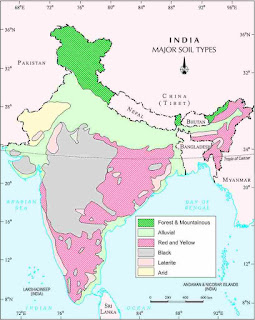How many Types of Soil in INDIA ??
India consists of Different types of Soil on the basis of Geographical location, Climate, Vegetation, Topography, Cropping pattern, pH, and Chemical content as Follows :
Major Soil Groups of India
1. Alluvial Soil
2. Black Soil
3. Red and Yellow Soil
4. Laterite Soil
5. Arid and Desert Soil
6. Forest Soil
7. Mountain Soil
8. Peaty and Marshy Soil
Let's Look into it!
1. Alluvial soils : -
• Alluvial soil is deposited by rivers such as the Indus, Ganges, and Brahmaputra, as well as in deltas of rivers like Mahanadi, Godavari, Krishna, and Kaveri and also in estuaries.
'Alluvial soils are also known as Depositional soils'
• Where founds : It is widespread in the northern plains, covering states like Arunachal Pradesh, Assam, Bihar, Chandigarh, Delhi, Haryana, Himachal Pradesh, Madhya Pradesh, Punjab, Rajasthan, Uttarakhand, Uttar Pradesh, and West Bengal. It also extends to Rajasthan and Gujarat through a narrow corridor.
• Alluvial soil is also found in the eastern coastal plains, particularly in the deltas of Mahanadi, Godavari, Krishna, and Kaveri rivers.
• Area under : It covers about 40% of the total land area of the country and is the most abundant soil in India. Sand content of alluvial soil decreases from west to east in the country.
• Alluvial soil is highly fertile and contains adequate proportions of potash, phosphoric acid, and lime, making it suitable for the cultivation of crops like sugarcane, wheat, and other cereals and pulses.
Soil Characteristics :
• It contains humus, lime, and organic matter, which contribute to its fertility.
• The color of alluvial soil varies from light grey to ash grey.
• The texture of alluvial soil ranges from sandy loam to clay.
• It is rich in potash but poor in phosphorus.
• There are two types of alluvial soils in the Ganga plains:
1) Khadar : Khadar is new alluvium found in flood plains and enriched with fresh silt deposits every year.
2) Bhangar : Bhangar is old alluvium deposited away from the flood plains and contains concretions of impure calcium carbonate called kankar.
• In the lower and middle Ganga plains and the Brahmaputra valley, alluvial soils are more loamy and clayey.
'Alluvial soils are also known as Depositional soils'
• Where founds : It is widespread in the northern plains, covering states like Arunachal Pradesh, Assam, Bihar, Chandigarh, Delhi, Haryana, Himachal Pradesh, Madhya Pradesh, Punjab, Rajasthan, Uttarakhand, Uttar Pradesh, and West Bengal. It also extends to Rajasthan and Gujarat through a narrow corridor.
• Alluvial soil is also found in the eastern coastal plains, particularly in the deltas of Mahanadi, Godavari, Krishna, and Kaveri rivers.
• Area under : It covers about 40% of the total land area of the country and is the most abundant soil in India. Sand content of alluvial soil decreases from west to east in the country.
• Alluvial soil is highly fertile and contains adequate proportions of potash, phosphoric acid, and lime, making it suitable for the cultivation of crops like sugarcane, wheat, and other cereals and pulses.
Soil Characteristics :
• It contains humus, lime, and organic matter, which contribute to its fertility.
• The color of alluvial soil varies from light grey to ash grey.
• The texture of alluvial soil ranges from sandy loam to clay.
• It is rich in potash but poor in phosphorus.
• There are two types of alluvial soils in the Ganga plains:
1) Khadar : Khadar is new alluvium found in flood plains and enriched with fresh silt deposits every year.
2) Bhangar : Bhangar is old alluvium deposited away from the flood plains and contains concretions of impure calcium carbonate called kankar.
• In the lower and middle Ganga plains and the Brahmaputra valley, alluvial soils are more loamy and clayey.
2. Black Soil :
• It is also known as regur soil or black cotton soil, as it is ideal for growing cotton.• Where Found : Black soil is predominantly found in the Deccan trap (Basalt) region, covering the plateaus of Maharashtra, Saurashtra, Gujarat, Malwa, Madhya Pradesh, Andhra Pradesh, Chattisgarh, and extending along the Godavari and Krishna valleys.
• Soil Characteristics : Black soil is rich in soil nutrients such as calcium carbonate, magnesium, potash, and lime but generally poor in phosphorus content.
• The soil is clayey in nature and has a high capacity to hold moisture.
• Due to its high clay content, black soil develops wide cracks during the dry season but is resistant to wind and water erosion due to its iron-rich granular structure.
• The soil is poor in humus but highly moisture-retentive, making it responsive to irrigation.
• The color of black soil varies from deep black to grey.
• It is generally deep and impermeable, swelling greatly and becoming sticky when wet in the rainy season and shrinking and developing wide cracks when dried. That's why it is also known as 'Self ploughing soil'
• Suitable Crops : Main crops cultivated in black soil include cotton, pulses, millets, castor, tobacco, sugarcane, citrus fruits, and linseed.
3. Red and Yellow Soil :
• Red and yellow soil is also known as the "Omnibus group."
• It covers approximately 18.5% of the total land area in India.
• This type of soil is found in regions with low rainfall, particularly in the eastern and southern parts of the Deccan Plateau. It is also present in parts of Odisha, Chhattisgarh, and the southern parts of the Middle Ganga Plain.
• The red color of the soil is due to the presence of iron in crystalline and metamorphic rocks. When in hydrated form, the soil appears yellow.
• The fine-grained red and yellow soil is generally fertile, while the coarse-grained soil is less fertile.
• Red and yellow soil is deficient in nitrogen, phosphorus, and humus.
• Main crops cultivated in red and yellow soil include wheat, cotton, oilseeds, millets, tobacco, and pulses.
• Red and yellow soil is mainly found in areas with low rainfall.
• It has a porous and friable structure and lacks lime and kankar (impure calcium carbonate).
• Red and yellow soil is deficient in lime, phosphate, manganese, nitrogen, humus, and potash.
• The color of the soil ranges from red to brown, chocolate, yellow, grey, or even black.
• The main parent rocks of red and yellow soil are acid granites, gneisses, quartzitic, and felspar rocks.
• Red soil develops on crystalline igneous rocks in areas of low rainfall in the eastern and southern parts of the Deccan Plateau.
• Yellow and red soils are also found in parts of Odisha, Chhattisgarh, West Bengal, Maharashtra, southern Karnataka, Tamil Nadu, and Madhya Pradesh.
• The red color is due to the diffusion of iron in crystalline and metamorphic rocks, while it appears yellow in a hydrated form.
• Red and yellow soil is also known as the "Omnibus group."• It covers approximately 18.5% of the total land area in India.
• This type of soil is found in regions with low rainfall, particularly in the eastern and southern parts of the Deccan Plateau. It is also present in parts of Odisha, Chhattisgarh, and the southern parts of the Middle Ganga Plain.
• The red color of the soil is due to the presence of iron in crystalline and metamorphic rocks. When in hydrated form, the soil appears yellow.
• The fine-grained red and yellow soil is generally fertile, while the coarse-grained soil is less fertile.
• Red and yellow soil is deficient in nitrogen, phosphorus, and humus.
• Main crops cultivated in red and yellow soil include wheat, cotton, oilseeds, millets, tobacco, and pulses.
• Red and yellow soil is mainly found in areas with low rainfall.
• It has a porous and friable structure and lacks lime and kankar (impure calcium carbonate).
• Red and yellow soil is deficient in lime, phosphate, manganese, nitrogen, humus, and potash.
• The color of the soil ranges from red to brown, chocolate, yellow, grey, or even black.
• The main parent rocks of red and yellow soil are acid granites, gneisses, quartzitic, and felspar rocks.
• Red soil develops on crystalline igneous rocks in areas of low rainfall in the eastern and southern parts of the Deccan Plateau.
• Yellow and red soils are also found in parts of Odisha, Chhattisgarh, West Bengal, Maharashtra, southern Karnataka, Tamil Nadu, and Madhya Pradesh.
• The red color is due to the diffusion of iron in crystalline and metamorphic rocks, while it appears yellow in a hydrated form.
4. Laterite Soil :
• Laterite soils are mainly found in Karnataka, Kerala, Tamil Nadu, Madhya Pradesh, Andhra Pradesh, and the hilly areas of Odisha and Assam.• These soils are particularly useful for growing tea and coffee after adopting appropriate soil conservation techniques in the hilly areas of Karnataka, Kerala, and Tamil Nadu. Red laterite soils in Tamil Nadu, Andhra Pradesh, and Kerala are more suitable for cashew nut crops.
• Laterite soil develops in areas with high temperature and heavy rainfall, resulting in intense leaching due to heavy rain.
• The humus content of laterite soil is low because microorganisms, especially decomposers like bacteria, get destroyed due to high temperature and lack of organic matter.
• Laterite soils are deficient in organic matter, nitrogen, phosphate, and calcium, but abundant in iron oxide and potash.
• Although low in fertility, laterite soils respond well to manures and fertilizers.
• They are characterized by the monsoon climate, which is characterized by seasonal rainfall.
• Laterite soils are red in color due to the presence of iron oxide.
• They are found in Karnataka, Tamil Nadu, Kerala, Madhya Pradesh, and hilly regions of Assam and Odisha.
• Red laterite soil in Kerala, Tamil Nadu, and Andhra Pradesh is well-suited for cultivating tree crops like cashew nuts.
• Laterite soil hardens rapidly and irreversibly when exposed to air, making it suitable for use as building bricks in southern India.
• Main crops cultivated in laterite soil include rice, ragi, sugarcane, and cashew nuts.
5. Arid / Desert Soil :
• Desert or arid soil is found under arid and semi-arid conditions.• It is mainly deposited by wind activities.
• Arid soil has a high salt content and lacks moisture and humus.
• The presence of kankar or impure calcium carbonate restricts the infiltration of water.
• Nitrogen content in arid soil is insufficient, while phosphate content is normal.
• The texture of arid soil is sandy.
• The color of arid soil ranges from red to brown.
• These soils are saline in nature, and in some regions, the salt content is high enough to obtain common salt through water evaporation.
• Due to the dry climate and high temperature, evaporation is faster, resulting in a lack of organic matter and moisture needed for humus formation.
• The lower horizons of the soil are occupied by kankar layers due to increasing calcium content downwards, which restricts water penetration.
• With proper irrigation, desert soils can become cultivable, as seen in the case of western Rajasthan.A
• Arid soil accounts for over 4.42% of the total land area of the country.
• It is sandy to gravelly in texture with low moisture content and water-retaining capacity.
• Desert soils have normal phosphate content but are deficient in nitrogen.
• They are predominantly found in western Rajasthan and contain little humus and organic matter.
6. Forest Soil :
• Forest soils are found in regions of high rainfall, particularly in hilly and mountainous areas.• The texture of forest soil varies depending on the mountain environment. It is typically loamy and silty on valley sides and coarse-grained in the upper slopes.
• Forest soil is acidic in nature and has a lower humus content, especially in snow-covered areas.
• These soils occupy about 2.85 lakh sq km, which is approximately 8.67% of the total land area of India.
• Forest soil formation is primarily influenced by the deposition of organic matter derived from forest growth.
• Forest soils are heterogeneous, and their characteristics can vary based on parent rocks, ground configuration, and climate.
• In the Himalayan region, forest soils are mainly found in valley basins, depressions, and less steeply inclined slopes, with north-facing slopes being more likely to have soil cover.
• Forest soils are also found in the Western and Eastern Ghats and some parts of the Peninsular plateau.
• These soils are rich in humus but deficient in potash, phosphorus, and lime. Fertilizers are often required for high yields.
• Forest soils are particularly suitable for plantations of tea, coffee, spices, and tropical fruits in Karnataka, Tamil Nadu, and Kerala. In Jammu and Kashmir, Himachal Pradesh, and Uttaranchal, they are suitable for wheat, maize, barley, and temperate fruits.
7. Mountain Soil:
• Mountain soil is found in the forest regions where rainfall is sufficient.• The texture of mountain soil depends on the mountain environment where it is found.
• These soils are coarse-grained in the upper slopes and loamy and silty on valley sides.
• In the snowbound areas of the Himalayas, mountain soils undergo denudation and have low humus content, making them acidic.
• However, the soils found in the lower valleys are fertile.
• Mountain soil is also known as forest soil.
8. Peaty/Marshy soil :
• Peaty/marshy soils are found in regions of heavy rainfall and high humidity, where the growth of vegetation is limited.• These soils contain a large quantity of dead organic matter, known as humus, which makes the soil alkaline.
• Peaty soils are generally heavy and have a black color.
• They are rich in humus and organic matter.
• In many places, peaty soils are alkaline in nature.
• Peaty soils are found in specific regions such as southern Uttarakhand, the northern part of Bihar, and the coastal areas of West Bengal, Odisha, and Tamil Nadu.
• These soils originate in humid regions where there is a significant accumulation of organic matter in the soil.
• Peaty soils contain soluble salts and have a high organic matter content ranging from 10-40%.
• In Kerala, peaty soils are known as "kari" and are found in districts like Kottayam and Alappuzha.
• Marshy soils with a high proportion of vegetable matter also occur in coastal areas of Odisha and Tamil Nadu, the Sunderbans in West Bengal, Bihar, and Almora district in Uttaranchal.
• Peaty soils are highly acidic and deficient in potash and phosphate.
• Most peaty soils are submerged in water during the rainy season but are utilized for paddy cultivation once the rains cease.
Map of India showing Different Soil Types :
 |
| Soil types in India Map |
Conclusion :
These are the 8-9 Soil types of group found in Indian Territory. They follows according to them Cropping pattern.
Read also :
✓ Agro Climatic Zones of Maharashtra
✓ Agriculture Books for Competitive by Toppers







